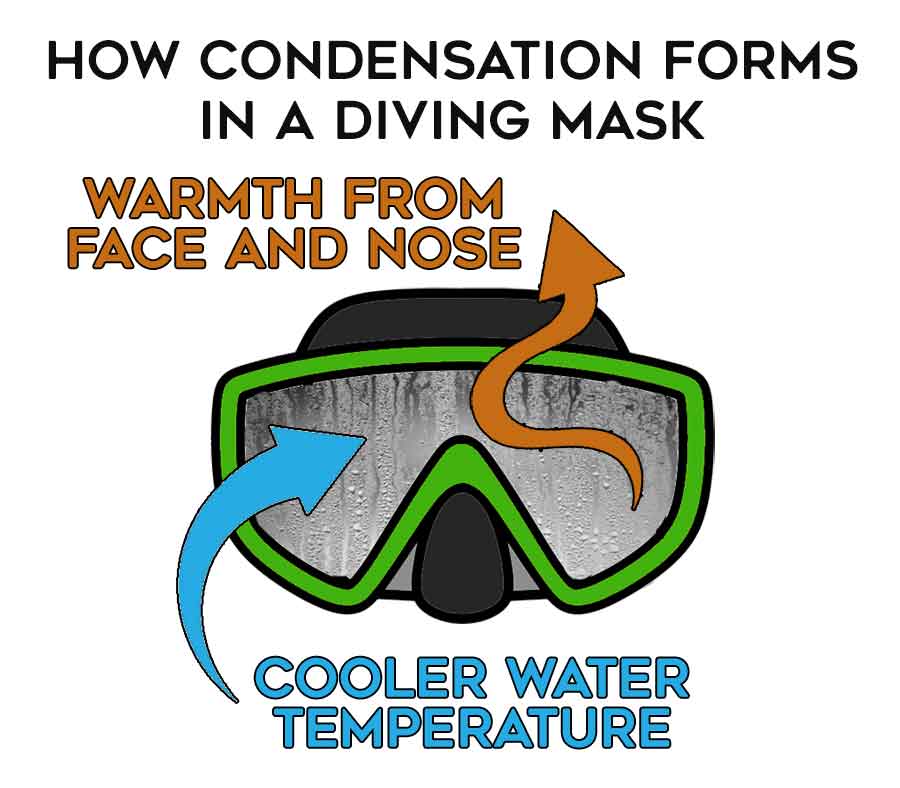Solve Dive Mask Fogging: Your Expert Guide To Prevent Mask Fog
Are you tired of missing out on the breathtaking underwater beauty because your dive mask keeps fogging up? If crystal-clear dives are what you desire, you’ve come to the right place.
In this comprehensive guide, I have all the information you need to prevent dive mask fogging once and for all. Say goodbye to the frustration of a constantly fogging dive mask and hello to stress-free underwater experiences.
Why do Diving Masks Fog?
Before we delve into methods for preventing masks from fogging, it’s crucial to understand why diving masks fog up in the first place.
Dive masks fog up because of temperature differences. Inside the mask, your face and the air you exhale from your nose are warm and humid. But the water around you is cool. When the warm air from your face and breath meets the cold water on the mask lens. This causes condensation to form.

Condensation Inside Dive Masks
Condensation is when warm, moist air turns into tiny water droplets when it touches something cold. These tiny water droplets stick to the inside of the mask, making it look foggy. It’s the same as when your breath fogs up a window on a cold day.
With new diving masks, the main culprit that causes condensation comes from the manufacturing process.
When a new dive mask is produced, a thin film of silicone residue is left on the inside of the glass lenses.
This residue allows more condensation to form on the mask lens when you are diving. As a result, it needs to be removed to prevent fogging during your dives.
How to Prepare Your New Diving Mask to Prevent Fogging
To prepare your new mask for diving, it is vital to remove the silicon residue from the inner mask lens.
Here is my own, very effective, method for doing that:
Preparing your new diving mask is a simple 2-step process:
Step 1: Heat the inner-mask lens
Using a naked flame is a quick way to remove silicone residue from the inner mask. It’s vital to avoid strong flames like jet lighters.
- Use a lighter or tapered candle for this method.
- Keep the flame in constant motion to prevent overheating the mask.
- Glide the flame over the lens until it turns black (soot from the burnt silicon residue) Use a lighter or tapered candle for this method.
- After turning the lens black, allow it to cool and wipe away soot with a soft cloth.
- Repeat this process until soot is no longer produced.
Important Points:
- Ensure the glass doesn’t become excessively hot by holding the flame still.
- Use the same amount of movement that would allow you to pass a flame under your palm without hurting.
- Do not use this method on masks with plastic lenses as they may melt.
- Be cautious not to expose the mask’s silicone skirt and lens seals to flame as they can be damaged.
If you are too anxious to use a flame on your diving mask, you can omit this process and proceed directly to step 2. However, that step will consequently take a lot more time and may not provide such good results.
Step 2: Mild abrasives for preparing a new diving mask
Scrubbing the mask with a mild abrasive effectively removes any remaining silicone residue. You have two options:
- Mr. Clean Magic Erasers: These are efficient and quick, taking just seconds to do the job.
- Commercial Mask Scrub: These are abrasive solutions designed for preparing masks (and cleaning dive slates).
- Toothpaste: White fluoride-based toothpaste (avoid gel-type) can also be used. Here’s how:
- Apply a thimble-sized amount to the inside of both lenses.
- Spread the toothpaste evenly with a circular rubbing motion, using a cotton bud for hard-to-reach areas.
- Let the toothpaste dry for 10-15 minutes.
- Rinse the lenses under a tap, removing all toothpaste residue.
Repeat these steps 3-4 times, ensuring the lenses are dry between each application.
Pre-Dive Steps to Stop Your Diving Mask From Fogging
Once your new diving mask is treated to reduce the likelihood of fogging, you will still have to prepare it before each dive. Removing the silicon residue by itself is not enough to prevent diving masks from fogging.
Condensation can still form inside a mask lens when the warmth of your face and exhaled breath meets the cold water outside the lens.
There are 3 options for preparing your mask before each dive:
- The Spit and Rub Method
- Commercial De-Fogging Solutions
- Baby Shampoo
1. The Spit and Rub Method
Spitting inside your mask might sound unhygienic, but it’s actually a very common and effective method to combat mask fog.
Many experienced divers find using saliva to defog their masks the most convenient and far more economical option.
The process is simple: spit, rub, and rinse.
- Spit onto the inner lens of your mask
- Rub it with your finger
- Briefly dip the mask in fresh water.
The goal is to leave a thin layer of saliva coating the inner mask lens to prevent condensation from forming.
- Use this process immediately before entering the water.
- It is less effective if your inner mask lens dries out before you submerge.
2. Commercial Mask De-Fogging Products
Commercial de-fogging products for diving masks, available as gels or sprays, help to ensure clear underwater vision. These products are designed for snorkeling, freediving, and scuba diving masks, work similarly, and are cost-effective. They are often sold in dive centers and diving resorts or are available to purchase online.
Commercial de-fogging products cost approximately $6-15 for a two-ounce (60ml) bottle, which can last for many dives.
- Apply by spraying or rubbing gel onto mask lenses.
- Leave the solution to dry for a short while before diving.
- Rinsing briefly to leave a thin, effective layer inside the mask
3. Baby Shampoo
Using baby shampoo as a defogging solution is a practical alternative to commercial de-fogging products. It is easily available in any pharmacy, supermarket, or convenience store around the world. As a result, many divers include a diluted baby shampoo solution in their dive bag.
- Applying a few drops onto the lens and then giving it a brief rinse effectively prevents mask fogging.
- Baby shampoo is preferred over regular shampoo due to its hypoallergenic, eye-friendly, and biodegradable qualities.
- Some divers enjoy the pleasant fragrance of baby shampoo as an added bonus.
Dealing With a Fogging Mask During Your Dive
If your diving mask fogs when you are underwater, you will have to partially flood and clear your mask to restore vision.
This is usually only a temporary solution. If condensation is forming inside your mask, it is liable to keep reoccurring throughout your dive.
Repeat the process below whenever your vision through the mask decreases.
How to partially flood and clear your dive mask
- Breathe normally and naturally through your regulator.
- Keep your head horizontal so that there is less chance of any water going down your nose.
- Using your fingers, gently break the lower seal of your dive mask skirt. Only a tiny gap is needed to permit a small trickle of water to enter your mask.
- Move your head around to swirl the water around the inside of your dive mask until all the condensation is removed from inside the lens.
- Keep the top of your diving mask sealed by placing some light pressure on the upper frame (above your eyebrows) using your fingers.
- Exhale very slowly through your nose. The addition of air into your mask displaces water from it.
- The aim is not to powerfully “blow” air into your mask, because a majority of it will simply disappear straight out from under the lower seal of the mask.
- Remember, the aim is to fill the mask with air, not blow the water out.
Once you have cleared the majority of water out of your diving mask, you may notice a small amount remains persistently at the bottom of the lens. This depends upon the mask design.
To get rid of that last persistent bit of water from your mask, simply raise your head by 45 degrees and repeat the slow exhalation process from your nose.
Top Tips to Reduce Dive Mask Fogging
Even with these preparations, sometimes mask fogging can persist. Here are some additional tips:
- Avoid touching the inside of your mask, especially after using defog products, as oils from your skin can negate their effects.
- Refrain from exhaling through your nose while diving, as this is a common cause of fogging.
- Ensure your mask fits properly to minimize moisture entering it during the dive.
Prevent Dive Mask Fogging When Diving
In conclusion, the end to frustration from dive mask fogging is well within your grasp. I’ve found these methods to be the best option for immediate results, and you’re now equipped to enjoy crystal-clear underwater adventures.
- Remember to prepare your mask properly with flame and an abrasive rub.
- Consider commercial mask-defogging solutions, baby shampoo, or the free method of ‘spit and rub’.
- Practice the skill of partial flooding and clearing your mask to remove any fogging when you are underwater.
Enjoy your future scuba diving with confidence, knowing that fogged masks won’t add to your stress or ruin your view.
As you venture into the depths, keep honing your skills and exploring new ways to enhance your diving experience. Share this article with fellow divers and help them to dive without the nuisance of fogged masks.
Dive Mask Fogging FAQs
Warmth from the face and air exhaled through the nose heats the inside of the diving mask. Cooler water temperature outside of the mask causes condensation to form inside the mask lens.
Treat the mask’s inner lens with either commercial defog solution, baby shampoo, or saliva. Rub it into the mask and then rinse in fresh water before diving.
Commercial mask-defogging solutions are the most expensive option but are effective. Alternatives are baby shampoo or simply saliva (spit).
Gently burn away residual silicone coating the inner lens, then use a mild abrasive to polish the inner lens. Rinse and repeat as necessary until the mask does not fog.
Partially flood the mask and use the water to clean the mask lens. Clear the mask using basic mask clearing techique.
About The Author

Andy Davis is a RAID, PADI TecRec, ANDI, BSAC, and SSI-qualified independent technical diving instructor who specializes in teaching sidemount, trimix, and advanced wreck diving courses.
Currently residing in Subic Bay, Philippines; he has amassed more than 10,000 open-circuit and CCR dives over three decades of challenging diving across the globe.
Andy has published numerous diving magazine articles and designed advanced certification courses for several dive training agencies, He regularly tests and reviews new dive gear for scuba equipment manufacturers. Andy is currently writing a series of advanced diving books and creating a range of tech diving clothing and accessories.
Prior to becoming a professional technical diving educator in 2006, Andy was a commissioned officer in the Royal Air Force and has served in Iraq, Afghanistan, Belize, and Cyprus.
In 2023, Andy was named in the “Who’s Who of Sidemount” list by GUE InDepth Magazine.
Purchase my exclusive diving ebooks!
Originally posted 2023-09-28 17:28:43.















